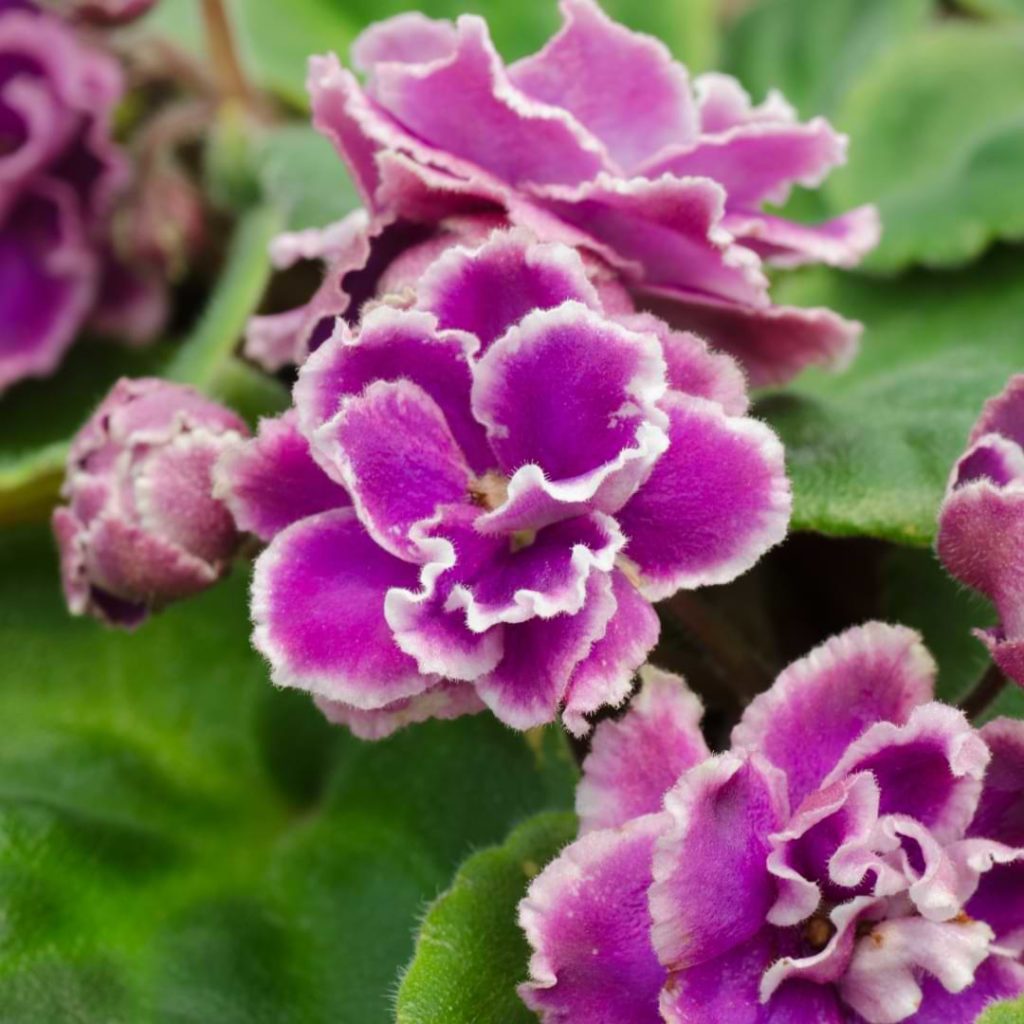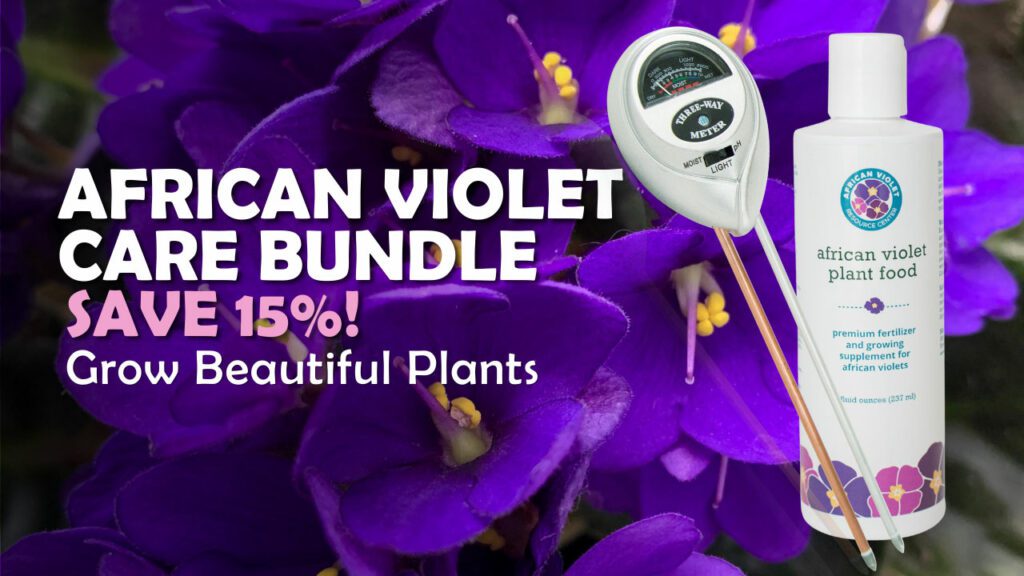African violets are beloved houseplants because they are easy to care for and capable of producing beautiful blooms nearly year-round. The only thing that would make them more attractive to houseplant owners is if the plants could be even more prolific.
Turns out that more prolific African violets do exist. Trailing African violets are similar to traditional African violets when it comes to growing requirements, but trailing African violets produce cascading growth with even more blooms than a traditional African violet plant.
Keep reading to learn more about trailing African violets and how to take care of this unique type of African violet.
What Are Trailing African Violets?
Trailing African violets are sometimes confused with African violets that have developed more than one crown. With this variety, each crown has its own root system. Instead, trailing African violets naturally have multiple crowns with just one root system. These crowns have more space between the leaves, which keeps them from being too tightly packed together.
Types of Trailing African Violets
Trailing African violets are classified based on the size of the leaves. Be aware that the classification of African violets do not refer to how large the plant will ultimately grow. Since the classification refers only to the size of the leaves, even micro-miniature trailing African violets can expand a great deal.
- Micro-miniature
- Micro-miniature trailing African violets have leaves that are less than 1/2 an inch long.
- Miniature
- Miniature trailing African violets have leaves that grow up to 1 inch long.
- Semi-miniature
- Semi-miniature trailing African violets have leaves that grow up to 2 inches long.
- Standard
- Standard trailing African violets have leaves that grow up to 3 inches long.
How to Grow Trailing African Violets
Because trailing African violets have similar requirements as traditional African violets, there are just a few key differences between how to grow the two types of plants. Keep reading to find out exactly what you need to know to encourage this variety to grow well.
Growing From Seed
African violets can be grown from seed, but due to how African violets reproduce via seed, there’s no way to know what characteristics your African violet will have in advance. That being said, if you aren’t particular about the colors, leaf sizes, or leaf shapes of your trailing African violet, it can be fun to try growing them from seed.
First, you’ll need to obtain trailing African violet seeds from a reputable source. Generally, you’ll only be able to order these seeds online. You can technically cross-pollinate your own African violets, but the process is long and not always successful.
Once you have your trailing African violet seeds, it’s time to set things up. Prepare the growing medium by adding tap water to African violet potting soil until the soil is moist. Usually a few tablespoons of water per cup of potting soil is just right. Then spread at least a ½ inch layer of potting soil in a shallow container. Avoid pressing the soil down too much.
Since African violet seeds are tiny, slowly tap a few seeds from the seed envelope onto a piece of paper. Then tap the paper to evenly spread the seeds across the shallow container. Not all the seeds will germinate, so add a few more seeds just to be sure.
Cover the container with a clear plastic lid or with plastic wrap to trap in moisture and ensure the seeds’ environment stays humid. Mist with more water if the soil seems to dry out while waiting for seeds to germinate.
Keep the seeds warm in temperatures between 70 to 80 degrees in a sunny location where they will receive about 10 hours of light a day.
In about 2 weeks, some of the seeds will begin to sprout, but other seeds may take up to 5 weeks to sprout. The seeds develop slowly at first, but if you’re patient, you’ll have a variety of different trailing African violets eventually.
Propagating
Propagating African violets by leaf cutting is more common than starting from seeds. Cuttings produce fewer new plants, but the wait is significantly shorter. Plus, you’ll know what type of trailing African violet to expect because it will be an exact copy of the original plant.
You can either propagate African violet leaf cuttings in water or soil. In my opinion, propagating in soil is the easiest because propagating in water requires an extra step, but both work equally well.
Here’s what to do to propagate trailing African violets through leaf cuttings.
First, select a few healthy leaves to propagate. Pick a few more than you think you’ll need because there’s always a couple that don’t make it. Healthy leaves should be free of brown spots or holes.
Pinch the leaves you’ve selected from the trailing African violet. Then use sterile tools like scissors or a knife to create a 45-degree cut on the stem about 1½ inches from the leaf.
If you’re propagating in soil, fill your containers with slightly moist African violet soil. Poke a small hole in the soil where you want to place each leaf. Then place a stem in each hole, burying the stem to the base of the leaf. You’ll probably need a small object like a plant tag or popsicle stick to keep the leaf from falling over.
If you’re propagating in water, fill each jar or container with water and cover the top with plastic wrap. Poke a tiny hole in the plastic and place the cutting through the hole, making sure the stem can reach the water. Change out the water every 7-10 days. Once the new plants are about ½ inch in size, take the plant out of the water and place it in a new tiny pot filled with African violet potting soil.
After this point, for both methods, you probably won’t need to move your tiny new trailing African violets for a while. Instead, focus on giving them enough sunlight and water just like you would with a mature African violet. You’ll likely need to water more frequently, though, because smaller containers dry out more quickly.
African violets seem to develop at a glacial pace in the beginning, so don’t worry if yours don’t seem to be doing much at first.
Position
All African violets require a lot of light, but for trailing African violets, it’s even more important that they get an adequate amount of light. Otherwise, they will start to get leggy quickly.
Place trailing African violets in a window where they will receive at least 8 hours of sunlight per day. They can handle up to 14 hours of light a day, but they do need at least 8 hours of darkness to bloom.
Depending on your area, you may need to supplement natural light with artificial light, especially in the winter. Normally, I advise that using artificial light during the winter months when you don’t have a window with enough light is optional if you’re fine allowing your traditional African violets to stop blooming for a little while. However, trailing African violets can really benefit from supplemental artificial light when the days get short in the winter.
Temperature and Humidity
Just like traditional African violets, trailing African violets thrive in average household conditions. They prefer temperatures around 70 degrees Fahrenheit, but are happy in temperatures between 60-80 degrees Fahrenheit. Avoid exposing them to colder temperatures for extended periods of time as it can be difficult for these plants to recover afterward.
Trailing African violets are happiest in high humidity environments, but they do just fine in the humidity level of the average home. If your household humidity levels are between 40-60%, your trailing African violets shouldn’t have an issue.
If your humidity levels are on the lower side, then create a humid microclimate by grouping multiple plants together in the same area or place shallow trays of water nearby. Both of these strategies can raise the humidity levels in a small area.
However, if your humidity levels are significantly lower, it may be worth investing in a humidifier. Low humidity levels can make people uncomfortable too, so a humidifier would improve conditions for both you and your trailing African violets.
In the average household, you probably won’t need to make adjustments to the temperature or the humidity to keep your African violets happy and thriving.
Soil Conditions
African violets aren’t finicky compared to most houseplants, but they are picky when it comes to soil. Just like traditional African violets, trailing African violets do best in light, well-draining soil that is slightly acidic. You can either make your own African violet soil or purchase a commercial potting mix designed for African violets.
Regular indoor plant potting soil holds on to too much moisture and can cause root rot in African violets. Stick to a lighter mix for African violets. Since these plants are so popular, it isn’t difficult to find the correct type of potting mix.
Buying Potted Plants
Trailing African violets aren’t as common as traditional African violets. You probably won’t run across trailing African violets at the grocery store or at big box stores. However, garden centers or other places that sell a large selection of indoor plants are likely to have some trailing African violets.
If necessary, trailing African violets can also be ordered through online sources. While it’s fun to pick out plants in person, there are multiple reputable sellers who can ship trailing African violets or trailing African violet cuttings directly to you.
Growing in Hanging Baskets or Macrame
Trailing African violets look like their most attractive selves in hanging baskets that allow their branching trailings covered in beautiful blooms to hang down over the sides. Unfortunately, since trailing African violets prefer shallow, wide containers, it’s difficult to find pre-made hanging baskets in the right size.
It’s much easier to find a normal shallow container and then make or purchase a macrame holder that fits to convert the container into a hanging basket.

Caring for Trailing African Violets
Trailing African violets are African violet hybrids that are generally easy to care for. If you can care for traditional African violets, you shouldn’t have an issue taking care of trailing African violets. Still, there are a few differences you should be aware of when it comes to care.
Watering Trailing African Violets
To adequately water trailing African violets, follow the same guidelines you would with traditional African violets. The exact watering schedule will vary depending on environmental factors. However, trailing African violets should be watered whenever the top inch of soil is dry.
Use room-temperature water. Top watering or bottom watering works equally well as long as you avoid getting water on the leaves. Either way, be sure your plant’s container has adequate drainage holes to allow excess water to escape. Overwatering can cause root rot, so it’s important that excess water be able to drain quickly.
Fertilizing
If you are familiar with caring for traditional African violets, you may find that trailing African violets need fertilizer more frequently. This is because trailing African violets have more leaves and blooms, so they use up the available nutrients in the soil more quickly.
You’ll still want to use a gentle, balanced fertilizer for trailing African violets. We suggest using a liquid fertilizer like African Violet plant food that you can use each time that you water. As always, I advise using minimal amounts of fertilizer at first to avoid overfertilizing, but you will probably find you’ll need to increase the amount of fertilizer used as your trailing African violet grows larger.
Pruning and Grooming
Trailing African violets also require a little more pruning and grooming to look their best. Like with traditional African violets, you should remove any leaves that are spotted or damaged and get rid of dead leaves and blooms.
However, you can also pinch off any leaves or crowns that cause the trailing African violet to look lopsided. Trailing African violets don’t grow quite as uniformly as traditional African violets, but removing a few leaves helps promote growth, so removing a couple leaves here and there benefits the plant.
How do you deadhead an African violet?
To deadhead an African violet, all you need to do is snip off the dead bloom with a pair of scissors. Tearing off the bloom can injure the plant and provide an entryway for disease or fungus.
FAQ Trailing African Violets
FAQ: How do I know if my African violet is a trailer?
Trailing African violets usually have more space between the leaves surrounding the crown compared to traditional African violets where the leaves are densely packed around the crown. Trailing African violets also develop multiple crowns on a single root system instead of multiple crowns with their own individual root systems.
FAQ: Can I use regular potting soil for trailing African violets?
Trailing African violets do best in potting soil that is lighter than regular potting soil. For best results, use a potting mix designed for African violets.
Join the African Violet Club!
Whether you’re just starting out or are a seasoned grower, African Violet Resource Center has everything you need to help your plant grow vibrant and strong. Explore our other articles, visit our online shop, and connect with other houseplant lovers in our Facebook group to learn everything you need to know about this rewarding hobby!
More Great African Violet Resources
A Beginner’s Guide to African Violet Houseplants
A Quick Primer on African Violet Pots
6 Reasons Your African Violet Won’t Bloom and How to Fix Them







